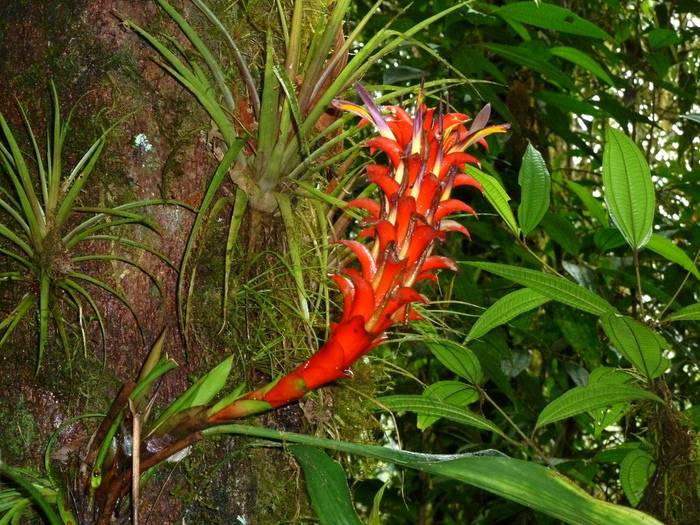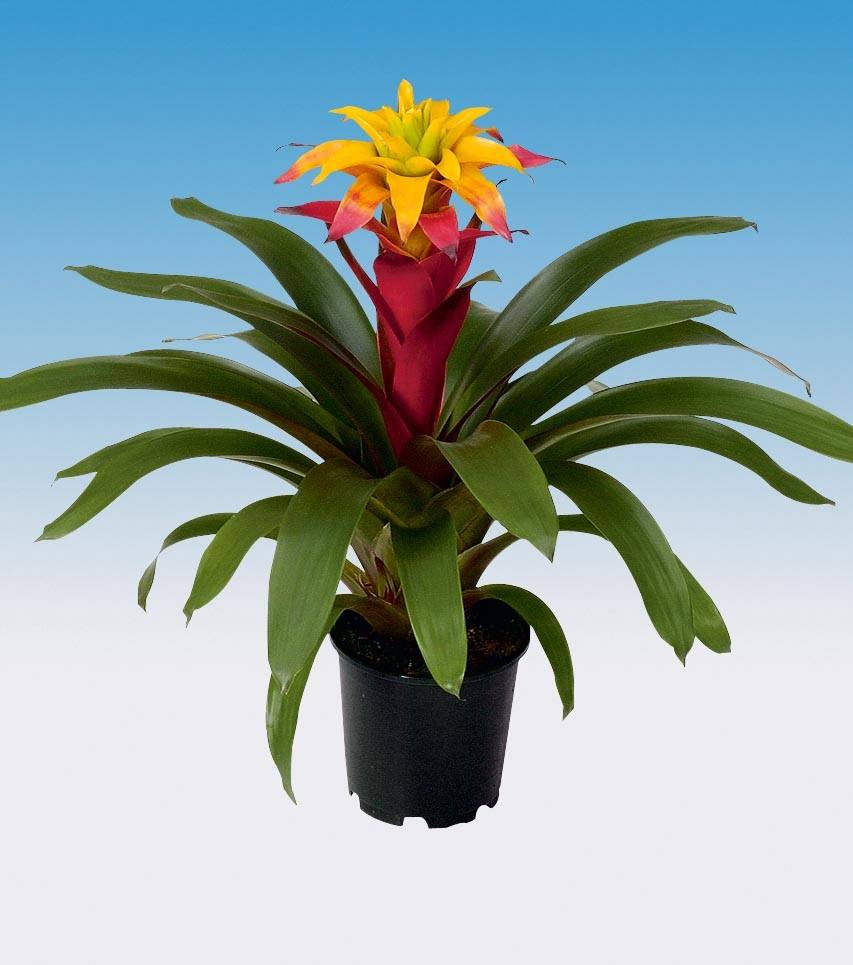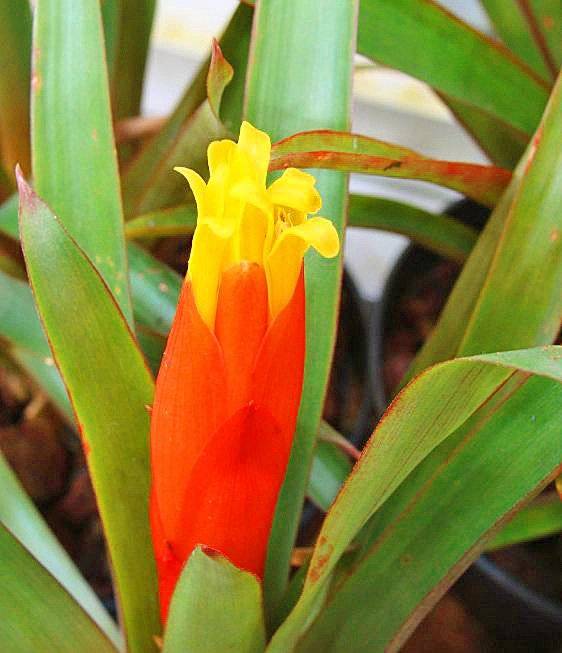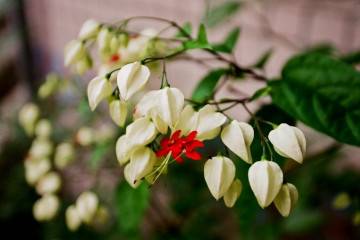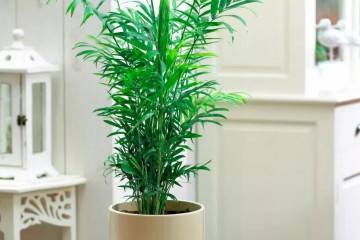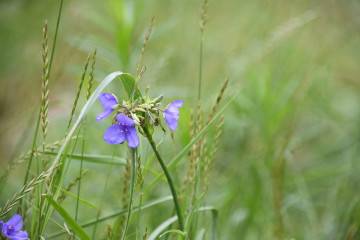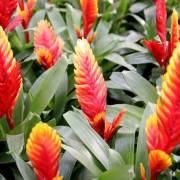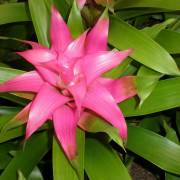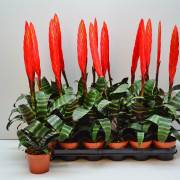Guzmania - flower care at home
Content:
Guzmania is a flower of the Bromeliad family. It is named after the biologist Anastasio Guzman who discovered it. In its natural environment, it grows in India and South America. Favorable conditions for the species are tropics, humid climate. There, plant varieties are found everywhere. In more northern latitudes, florists bring it out in artificial conditions.
What does guzmania look like
If plants grow in natural conditions, they are on trees, lead an epiphytic lifestyle. If you look at them from the side, you will get the feeling that the tree is blooming.
There are many types of plants, each of which has its own structure, inflorescences, shade. If we consider the wild variety, it reaches a height of no more than 30 cm.When growing indoor hybrids, a larger size can be achieved, up to 80 cm.
Leaves are glossy, grows in a circle in the shape of a bowl or glass. In the center is a peduncle and small flowers. The stem is thick, bright, saturated.
The main feature of a flower is its viability only until the moment of flowering. The variety has stems and leaves without inflorescences. In this form, it grows for 3 years.
But a florist can achieve further life by replanting branches - for this, proper planting and care must be carried out.
Despite the ability to bloom only once, flower growers often choose the type of guzmania - which brings into the house:
- air purification;
- decorativeness;
- pleasure for the grower to achieve a single bloom.
Care features
Guzmania care must be followed in accordance with all the rules so that the plant grows to a great height, blooms for several years. A certain temperature regime, irrigation method, transplantation are selected. If all the conditions are met correctly, the leaves do not turn yellow in the variety, it gradually grows in height up to 80 cm.
Temperature
Since the natural environment for a flower is a tropical climate, it likes high temperatures. On average, it should reach 25 degrees. But so that the leaves do not turn yellow, it is not recommended to set the temperature regime to more than 28 degrees.
In winter, the temperature is lowered to 20 degrees. It is not advisable to place the pot next to the battery. It is forbidden to set the temperature regime below 15 degrees, since the indoor guzmania flower will get sick and die.
Lighting
Lighting is one of the most important points in how to care for a room gusmania.
It is forbidden to allow direct sunlight, which can lead to burns, yellow and brown spots on the leaves. Since there is not enough sunlight in winter, it is recommended to expose the pot to southern windows so that the plant gets enough sunlight.
Watering
If a person cultivates one of the guzmania flower varieties, home care should include proper watering.
In summer, it should be abundant, it is forbidden to allow the soil to dry out.In winter, the frequency of watering is reduced, but the soil should not be dry. For a plant, the presence of stagnant moisture is detrimental, therefore it is recommended to wait until the liquid is completely absorbed.
Since the plant belongs to moisture-loving varieties, it is recommended to pour water into the outlet once a week. It is left until the contents are completely absorbed. The method does not allow the leaves to dry out. The water temperature should be 2 degrees above room temperature. That is, it should not be cold or hot.
Spraying
Many growers do not understand why the plant dries up despite frequent watering. This means that there is not enough moisture.
It can be replenished by spraying. It is carried out daily, using distilled or filtered water.
Humidity
The most suitable humidity is 80-85%. To achieve these results, it is recommended to use the following methods:
- applying wet sphagnum to the ground;
- installation of a container with water next to the pots.
Priming
For guzmania, the soil should be very loose. This allows particles of liquid and oxygen, which are necessary for the normal development of the flower, to leak out. It is recommended to use a store-bought substrate containing the following substances and ingredients:
- leafy soil, peat, sand, sphagnum;
- coconut flakes, leaf earth, crushed pine bark particles, sphagnum;
- soil, sand, crushed pine bark.
Top dressing
For normal life and flowering, it is recommended not to apply a lot of dressings.
Top dressing is done to accelerate flowering and increase the duration of this period. It is recommended to use ready-made bromeliad feed. But at the same time, a dosage is used 2 times less than what is written on the package. The contents of the sachet are poured directly into an outlet.
Transfer
To achieve flowering, you should know how to plant guzmania. Florists sell varieties in a shipping medium. But in order for the plant to take root and grow well, upon arrival home, transplant it into soil containing nutrients.
A transfer method is used, during which the plants are completely removed, shaken off the ground, and set in a pot. The neck must be completely intact, its slightest damage causes the death of the entire plant.
The transplant is done when soil drainage is disturbed, during which souring of the roots was formed. Also, the transplant must be used if the roots do not fit in the pot.
When it blooms
Flowering begins in late spring, early summer. There should be no pests, infections, viruses. A large flower appears from the outlet, which continues its life activity for 4 months. This is one of the few flowers that can delight with flowering for such a long period.
Flowering usually occurs in late spring, early summer. For it to appear, the gardener must adhere exactly to the recommendations for watering and soil care. The leaves and stems of the plant are unpretentious, but the flower can quickly die. If this happened, it makes no sense to save the entire flower, only part of its branches are transplanted for the repeated reproduction of the guzmania.
For guzmania grown at home, the presence of dormancy is not characteristic.
Possible problems
There are many different problems that a flower can have. Basically, they consist in improper care.
- Why does the plant wither despite watering? The problem is excessive overflow, which results in no fluid drainage.It is recommended to eliminate the liquid, establish drainage through which particles of excess moisture will come out.
- Why are the leaves sluggish, starting to turn yellow? Plants can stand in a place where there is a lot of bright sunlight, which is not recommended. The light should be soft, diffuse. Yellow leaves are a sign of a burn.
- Why are there white, brown, red spots or plaque? Guzmania, like many other types of flowers, is susceptible to parasitic infections and viruses. If this happens, pathogenic microorganisms begin to multiply intensively, which leads to the death of the trunk and roots.
- Why hasn't flowering been happening for many years? If the flower was planted 2-3 years ago, don't worry about blooming. It may not appear until 4 years of age.
- What causes multiple plants not to grow in height? In order for the flower to increase in height, you need to know about caring for the guzmania mix at home. It is imperative to transplant the flower into a new pot, when the root system has reached its maximum size, it does not fit in it.
- No daughter plants are formed. The stem, which was taken as a daughter plant, may not be viable, damaged, or various diseases. If he was healthy, the plant did not have proper care during transplants.
If a person has a guzmania plant, which brings aesthetics and beauty to the house, you should know that it requires certain care. You can't just water the plant periodically. It must receive all the nutrients for normal functioning.
Common varieties
There are hundreds of guzmania varieties, but only a few are the most common. They are actively grown by flower lovers at home, in offices, in the garden.
Guzmania reed
It is grown in houses and apartments, is small in size, up to 20 cm in height. The leaves are dark green below and slightly red above. The bloom is yellow or blue.
The flower is thick and short. After flowering, the plant lives for another 4 months.
Guzmania Donella Smith
Donell-Smith Guzmania rosette of green leaves, frames the peduncle. Inflorescences are blue, yellow. The bottom buds are open. This species can fertilize itself. The seeds have umbrellas that fly to a new habitat.
Guzmania blood red
The rosette is formed in the form of a large glass. During flowering, inflorescences of a bright red hue are formed. The peduncle is not developed. Up to 12 inflorescences are formed. They are located on a short peduncle and may have a yellow tint.
Guzmania musaika, or mosaic
This species differs from others in its leaves, it has no others. They have a green tint with stripes. This makes the plant unique. The inflorescence has a yellow tint. Plants grow wild in Panama.
Guzmania nicaraguensi
Rosette of leaves in the form of a glass. The peduncle is located in the middle, has a large number of inflorescences of white and red shades. In the wild, this species can be found in South America and Mexico.
Guzmania monostachia
The leaves have an emerald hue. They end with sharp edges, like swords. The inflorescence is single, but large, has a bright scarlet hue.
Guzmania Tsana (guzmaniazahnii)
The plant belongs to the largest varieties, which can be up to 80 cm long. The rosette is large and has the shape of a cup. An inflorescence of a bright red hue appears on the crown of the head.
Guzmania minor rondo
Guzmania minor rondo is popular with gardeners and flower lovers. This species is miniature, reaching up to 30 cm in height. It brings beauty and design to the apartments. Guzmania minor has good survival rate. It must be transplanted into pots, flowerpots.
Guzmania mix
Guzmania mix is not a separate species, but the name of several flowers collected in 1 pot.The inflorescence is less large, therefore it does not have a similar beauty with other species. But this disadvantage is compensated by the presence of colors of different shades.
Guzmania tempo
Guzmania tempo has a light green color, which turns into gold and yellow shades. The flowers are bright scarlet, so they decorate any room. The socket is dense, squat. Bracts are located close to each other.
Guzmania is a decorative flower that is grown indoors. It can grow in its natural environment, but in the tropics. The varieties should be approached with special care in order to achieve flowering.
